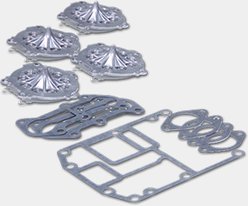The boat is secure on the trailer, the sun is going down and the whole crew has that special mix of happy and tired that only comes from spending a great day on the water. It’s incredibly tempting to call dibs on the first shower and just hit the road, but before you do, take a couple of extra minutes to do your part in stopping the spread of aquatic invasive species.
Simply stated, an aquatic invasive species – or AIS, for short – is any organism, typically a plant or animal, that is not native to a particular ecosystem. Often, there’s no way of knowing just how a given AIS will impact a new body of water until it’s too late. And as the invasive zebra mussel and Asian carp have taught us here in North America, the host ecosystems typically have no natural way of controlling the spread of a new AIS, often resulting in the AIS wreaking havoc on what were once healthy waterways. Consequently, it’s always better to leave all organic matter behind when pulling your boat out of the water.
That’s where you come in. In this Mercury Quick Tip video, you’ll see how just a few extra steps right after you pull your boat out of the water can help ensure that you don’t take any AIS – or eggs or seeds – to another body of water.
Here’s how to do it:
- Once the boat is on the trailer, pull it to the nearest possible out-of-the-way spot. A slight incline is preferred to facilitate more complete drainage.
- Remove the drain plug and make sure there is nothing preventing the bilge water from flowing freely.
- Lower all engines or outdrives to allow the water in the coolant passages to drain.
- Remove the plugs from all livewells and baitwells and let them drain completely.
- Starting at the rear of the boat, do a visual inspection for organic matter and remove it with your hands. Don’t forget the trailer, outdrive, swim platform, boarding ladders, transducers and anything else that tends to collect debris. You should also remove any mud or sediment you might have picked up as it can harbor seeds, eggs or tiny creatures.
- Continue the process down one side of the boat, paying special attention to the trailer rollers or bunks, as well as the axles, rims, brake lines and other hardware. A boat hook can help reach potential AIS material that is not easily accessible by hand. Repeat the process on the opposite side of the boat and trailer.
- Next, check the interior of the boat for any organic matter. Fishing tackle, tow ropes and the like can easily pull AIS material into the boat, and they can just as easily set it free in the next body of water you visit.
- Inspect the exterior of the boat from several angles to check for anything you might have missed the first time.
- If you’ve got a trolling motor, thoroughly inspect and decontaminate it as well.
- Finally, raise your engines or drives back up to the normal traveling position and you’re ready for the drive home.
While this process doesn’t take long for someone working alone, if you have one or more passengers with you to assist they can speed up the task dramatically. Working together will also help teach your family or guests about the threat of AIS and how they can help combat the issue. Just make sure you do the final inspection yourself because, as the boat owner, it’s ultimately your responsibility to ensure that your vessel is clean and free of any potential AIS material before you leave the immediate area of the waterway.
For more comprehensive information about AIS and what you can do to help stop the spread, visit the United States Department of Agriculture’s National Invasive Species Information Center website.























